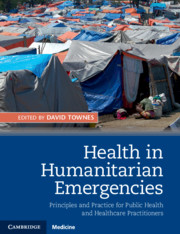 Health in Humanitarian Emergencies
Health in Humanitarian Emergencies Section II - Public Health Principles
Published online by Cambridge University Press: 26 July 2018
- Type
- Chapter
- Information
- Health in Humanitarian EmergenciesPrinciples and Practice for Public Health and Healthcare Practitioners, pp. 79 - 294Publisher: Cambridge University PressPrint publication year: 2018


